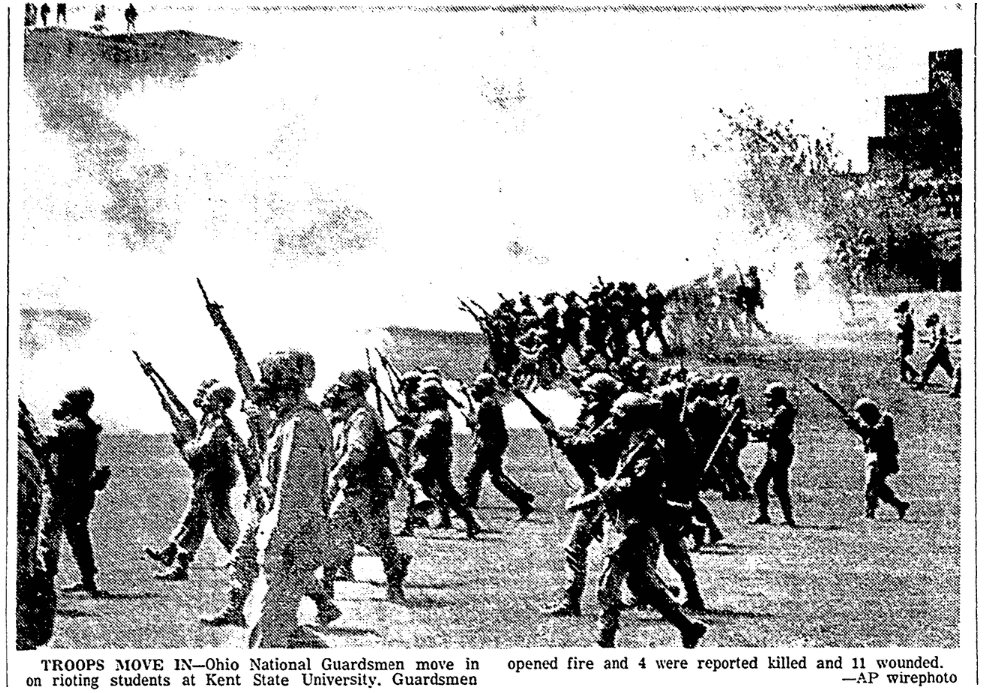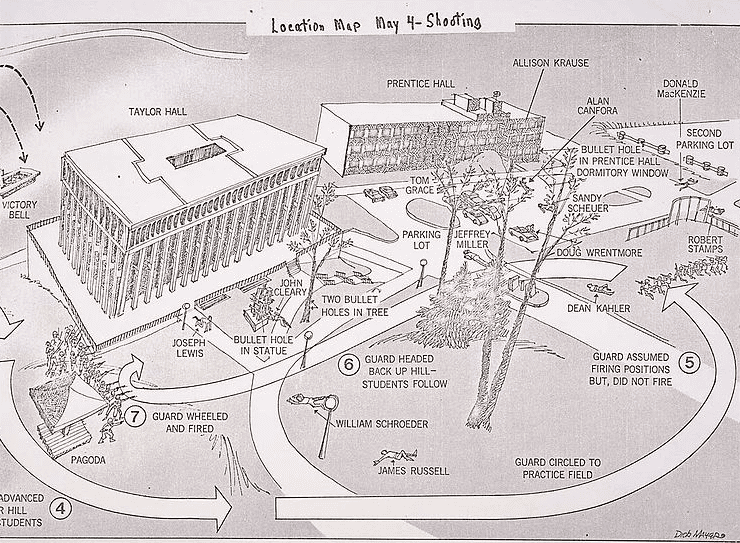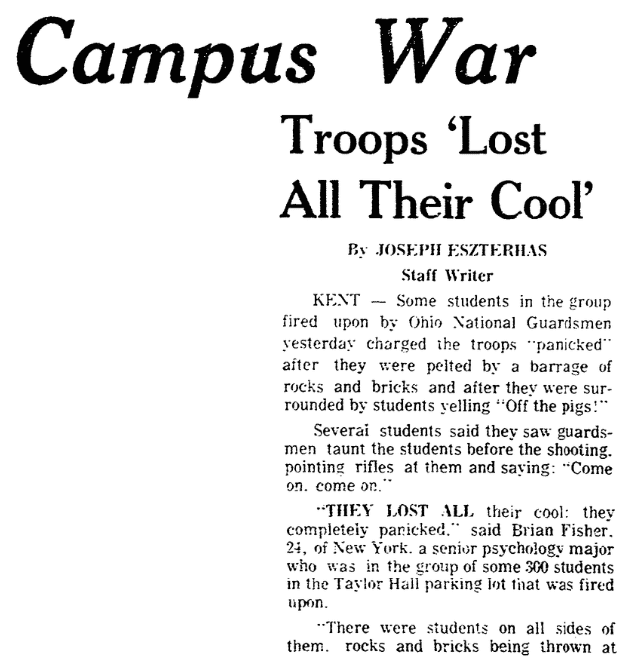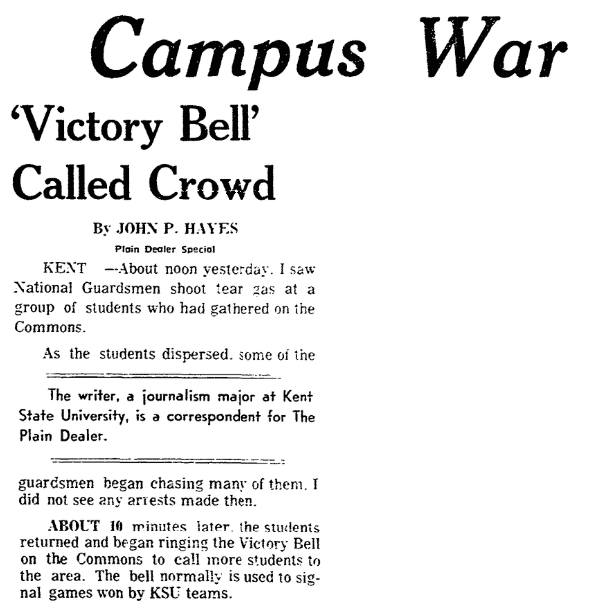The Kent State Shootings, when the Ohio National Guard shot 13 unarmed students on the campus of Kent State University on 4 May 1970, killing 4, was the culmination of rising tension on both the national and local fronts over American involvement in the Vietnam War. The shooting of college students on an American campus shocked the nation, and in the newspaper reports and vivid photographs of frightened, bewildered students it seemed to many that the violence of the war had come home to America.

Ending the war in Vietnam had been a heated issue during the 1968 presidential campaign, and when Republican Richard Nixon won, peace advocates tried to be mollified by Nixon’s promise to end the war. In November 1969 the chilling story of the My Lai Massacre was revealed, and repugnance at this bloody deed fueled increased anger at the war. Then, on 30 April 1970, Nixon admitted in a televised address to the nation that American troops had invaded Cambodia. Rather than the war ending, it seemed to be expanding and getting uglier.
That was the national backdrop to the rising tensions that exploded on the campus of Kent State University (KSU). Locally, the unrest began the day after Nixon’s Cambodian admission, when 500 KSU students demonstrated against the war in the center of the campus on May 1.
That night, a small riot broke out in downtown Kent, with smashed windows and looting. The mayor declared a state of emergency and asked for help on May 2, and that night Ohio Governor James A. Rhodes sent in the National Guard, who used tear gas and bayonets to break up another demonstration on campus. The two sides were at it again the next evening, May 3, when tear gas and bayonets were again used to break up a student demonstration on campus. All this set the scene for the violence on May 4.

What happened that day is reported in the following three newspaper articles, providing a wealth of detail and many eyewitness descriptions.

These three articles were published by the Plain Dealer on the front page of its 5 May 1970 issue.

Here is a transcription of this article:
4 DEAD, 10 HURT AT KSU
Campus Is Evacuated
By Michael D. Roberts
Staff Writer
KENT – Only the rumble of patrolling military vehicles was heard on the deserted Kent State University campus here last night after a day of violence in which four students were killed by gunfire of the Ohio National Guard.
At least 10 others were wounded after the troops fired about 50 rounds from M-1 rifles into a crowd of campus demonstrators.
It was the most tragic and bloody campus confrontation in the country since anti-war demonstrations began to erupt over Vietnam.
President Nixon said late yesterday that he would order a Justice Department investigation if the state so requested. Gov. James A. Rhodes, meanwhile, asked for the FBI to make an investigation.
Two hours after the shootings, University President Robert I. White ordered classes at the school, which has been racked by disorder since last Friday, suspended indefinitely.
Portage County Prosecutor Ronald Kane closed the university for an indefinite period, armed with an injunction from Common Pleas Judge Albert Carris.
By nightfall, 19,000 students and faculty had evacuated the campus.
Businesses in the city of Kent were closed and the approaches to the city were cordoned by police and guardsmen.
A curfew went into effect in Kent at 6 p.m. It will extend until dawn.
Officials at Robinson Memorial Hospital in Ravenna listed the dead as:
- Miss Allison Krause, 19, of Pittsburgh
- Jeffrey Miller, 20, of Plainview, N.Y.
- Miss Sandy Lee Scheuer, 20, of Youngstown
- William Schroeder, [19], of Lorain
Yesterday’s tragic events concluded student demonstrations and rioting on the campus and in the city that began Friday night in the wake of President Nixon’s address to the nation on fighting in Cambodia.
A massive demonstration protesting the arrival of the guard on campus Saturday night had been scheduled for yesterday noon on a grassy, central area of the campus called the Commons.
Observers said about 1,000 persons, nearly all students, responded to the peals of the school’s Victory Bell, normally rung after football triumphs.
Guardsmen from the 145th Infantry Regiment and the 107th Armored Cavalry aligned themselves in formation and called for the crowd’s dispersal.
When the milling and shouting students refused to obey, troopers fired tear gas from M-79 grenade launchers into the crowd which began to retreat in different directions.
“We had about 100 men in that formation,” said Brig. Gen. Robert H. Canterbury, assistant adjutant general of the National Guard, who was in direct command of the contingent. “They fired between 150 and 200 gas grenades into the crowd and dispersed them.”
The troops, wearing gas masks and carrying rifles, moved toward Taylor Hall, which stands on a high knoll and overlooks the Commons.
“There were a number of students gathering behind Taylor Hall and we moved toward them,” said Canterbury.
The guardsmen climbed from the Commons to Taylor Hall, occasionally firing tear gas into the crowd. By now the crowd was spread out and withdrawing toward a parking lot behind the hall and at the foot of [the] opposite side of the knoll.
It was here that the shootings took place.
The youthful crowd was shouting at the troopers to get off campus.
Some began to hurl stones at the guardsmen. Others threw sticks, according to witnesses.
“Many of the rocks were the size of baseballs,” said Canterbury. “I would characterize the conditions as being extremely violent at that moment.”
Several students at the scene said guardsmen poked rifles at the angered crowd and challenged them to come forward.
“At this point the troops had expended all their tear gas rounds and were ordered to return to the Commons,” said Canterbury. “We had dispersed the crowd and we were going to regroup.”
Canterbury said one shot was fired. “Several others followed. We deeply regret that people were shot. Many guardsmen were injured by the flying stones.”
A sergeant with the 107th Armored Cavalry, which had two companies from the Canton-Akron area at KSU, said he was hit with a brick. His arm was in a sling.
“It all happened so fast,” he said. “I couldn’t tell you what happened. I’m still under medication for my arm injury.”
Canterbury said no order was given to shoot.
“A military man always has the option to fire if he feels his life is in danger. The crowd was moving in on the men on three sides. The shooting lasted about two or three seconds,” the general said. [Note: other accounts say the shooting lasted anywhere from 13 to 25 seconds, and that 67 bullets were fired – ed.] “Officers at the scene immediately called for a cease-fire.”
When the initial shots rang out students were bewildered and disbelieving. Many thought the rifles carried blanks.
Few reacted until the .30-caliber rounds struck the crowd and splattered into the concrete around the parking lot.
Student witnesses said guardsmen were withdrawing when they turned and suddenly fired.
Canterbury said guardsmen fired from both kneeling and standing positions.
One reporter at the scene said he went down on a knee and then saw a figure spin and sprawl in front of him.
A girl to his left died instantly in a pool of blood at the parking lot entrance.
“Each guardsman carried an eight round clip,” Canterbury said. “Some had more than one clip, but we know how much each man had and we are in the process of investigating each man who fired his weapon,” Canterbury explained.
The general said that guardsmen have always been instructed to use their weapons if they were certain they were in danger.
One student onlooker said it appeared the soldiers panicked as the shouting students closed in on three sides.
Although rumors had persisted even prior to the shooting that guardsmen might be met by snipers, Canterbury would neither confirm nor deny such reports.
In Columbus, Adj. Gen. S. T. Del Corso, ONG commander, said: “A sniper opened fire against the guardsmen from a nearby rooftop.” [Note: the presence of a sniper has never been verified – ed.]
A student who climbed atop nearby Johnson Hall said he observed two policemen commanding the rooftop and they ordered him down.
In the aftermath, at least 67 persons, mostly students, were arrested by police. One student was held for carrying a concealed weapon, a rifle.
A girl was arrested after she was found carrying a knife.
Most were charged with curfew violations.
Canterbury said the immediate investigation into the shooting would determine which guardsman fired first, who fired and actually hit students, how many actually fired and how many rounds they expended.
Less than an hour after the shooting telephone service in the Kent area was placed on an emergency basis as parents and students tried to reach each other.
Ohio Bell said local lines were reserved for use of police, fire, hospital and communications agencies.
President White refused to appear before newsmen but expressed his sorrow over the tragic turn of events on his campus.
In Kent municipal court, many of those arrested were quickly meted both fines and jail sentences. In nearly all cases the sentences and fines were reduced.

Here is a transcription of this article:
Campus War
Troops ‘Lost All Their Cool’
By Joseph Eszterhas
Staff Writer
KENT – Some students in the group fired upon by Ohio National Guardsmen yesterday charged the troops “panicked” after they were pelted by a barrage of rocks and bricks and after they were surrounded by students yelling “Off the pigs!”
Several students said they saw guardsmen taunt the students before the shooting, pointing rifles at them and saying: “Come on, come on.”
“They lost all their cool: they completely panicked,” said Brian Fisher, 24, of New York, a senior psychology major who was in the group of some 300 students in the Taylor Hall parking lot that was fired upon.
“There were students on all sides of them, rocks and bricks being thrown at them,” Fisher said. “Everywhere they looked, they saw kids. The kids were on three sides.
“They didn’t know what to do,” he continued. “I saw about eight or nine of them hold their rifles out and say: Come on, come on!”
All the witnesses agreed there was loud chanting by the students: “Off the pigs, get the pigs off campus.”
Witnesses said that when the shooting began, someone yelled: “They’re shooting blanks, they’re just blanks.”
Debbie Moreland, 21, a senior from Cincinnati, also in [the] group, said: “Many persons didn’t take cover because they were under the impression blanks were being fired.
“I looked over towards the left,” she said, “and I saw a girl on the ground. I thought – oh my God, this isn’t really happening.”
Rick Levinger, 19, a freshman from New York City, said he was to the rear of the firing guardsmen.
He said he saw “20 to 30 guardsmen walking away from the students, then suddenly turn around at them and open up.”
Levinger insisted he heard one officer issue an order to fire.
“I saw those guys turn and get on their knees after I heard the officer order them to fire,” Levinger said.
(A National Guard spokesman later denied there had been an order to fire and said guardsmen fired both from standing and kneeling positions.)
Levinger also said he saw an officer with a .45-caliber pistol shoot first.
“After that, the others opened up,” Levinger said.
The officer he said shot first had been one of those earlier taunting students and saying: “Come on.”
Graduate student Lew Jefferies of Johnson Hall, adjacent to the shooting area, said that approximately 10 minutes before the shooting, there was a rumor of a sniper on the roof of Johnson Hall.
“I went up to the roof to see and there were two policemen there,” Jefferies said. “The two policemen told me there was no sniper. They said there was no one on the roof and urged we keep everyone off the roof. We barred the door to make sure no one could go up.”
Freshman Bill James, 19, also in the group fired upon, said: “We couldn’t believe what was happening. It all happened too quickly to begin with. People were yelling about blanks, but then I saw a girl on the ground bleeding from the neck.
“I went over to help her; I guess I was in a daze. I held her head. There was a huge hole in her neck – it looked like it had been ripped away.”
James said there “was no warning on any kind. We never expected them to shoot.”
He said that before the shooting, guardsmen had picked up some of the rocks thrown at them and had thrown them back.
Sherri Hotchkiss, 19, a freshman, said: “The guy next to me was yelling to get the pigs off when he got hit. There was blood all over his face. I ran behind a car and stayed there. There were three or four other kids there already. The car’s window had been shot out.”
David Sullivan, 19, of Bay Village, a freshman, was in his dormitory room looking at the shooting from his window.
“A girl was walking behind Taylor Hall,” Sullivan said. “The girl was walking away slowly. She had about four books in her arms. She was not in a part of the demonstration.
“Suddenly a shot ripped through her jugular vein and the bullet came out her eye,” he said. “She fell to the ground and I saw her lay in a pool of blood.”
Sullivan said: “The guard didn’t fire over heads. They just fired into the crowd. Twenty seconds of firing. It was a long string of bullets.”
Ronald P. McNees, 21, a junior from Parma, said he “looked right into the firing” from about 200 feet away.
“I ducked behind a tree and didn’t want to get shot. I thought they were shooting blanks because I couldn’t believe they were shooting to kill.
“It looked like the guard probably panicked because of the large number surrounding them.”
Ted Gersdorf, 21, a junior from Parma, said those taking part in the demonstration were not all radicals.
“They were jocks (athletes), moderates and some leftists. We just couldn’t take Nixon’s decision to go into Cambodia.”
“The soldiers who came in symbolized the whole Cambodian thing,” said Bob Wright, 20, a sophomore from Detroit. “The two things tied into one.”

Here is a transcription of this article:
‘Victory Bell’ Called Crowd
By John P. Hayes
Plain Dealer Special
(The writer, a journalism major at Kent State University, is a correspondent for The Plain Dealer.)
KENT – About noon yesterday, I saw National Guardsmen shoot tear gas at a group of students who had gathered on the Commons.
As the students dispersed, some of the guardsmen began chasing many of them. I did not see any arrests made then.
About 10 minutes later, the students returned and began ringing the Victory Bell on the Commons to call more students to the area. The bell normally is used to signal games won by KSU teams.
As more students arrived, the guard came back and again began shooting tear gas. I saw some students pick up gas canisters and throw them back at the soldiers.
The guardsmen moved in and took over the Victory Bell. I saw one student go up to a soldier and throw a tear gas canister at him.
Three soldiers began chasing the student up Taylor Hall hill. One soldier caught the student and began hitting him with a billy club while others pointed their rifles at him.
All this took about 20 minutes. The students still were running around with soldiers chasing them.
I saw the demonstrators being chased behind Taylor Hall by the soldiers. Other soldiers met them behind the hall. There was shooting. Some students fell to the ground. Reporters and photographers fell to the ground.
I immediately went into Taylor Hall where I felt I would be safe. At one time, I looked out a window and saw a guardsman point a rifle at me.
By 1 p.m. everything seemed peaceful. Students were just sitting there.
About 1:10, Dr. Martin R. Baron, chairman of the psychology department, began talking to approximately 2,000 students sitting on the hillside.
By 1:30, there were nearly 5,000 students around Taylor Hall hill.
The National Guard troops were in a straight line across the bottom of the hill at Portage Drive, near the art building and in front of the ruins of the burned Army ROTC building.
It looked as if about 1,000 guardsmen and state highway patrolmen were standing in the line.
Dr. Baron told the students a curfew was set for 6 p.m. and night classes were canceled. He told the students the faculty was behind them concerning Vietnam.
From what I could see, Dr. Baron had control of the students. He told them they had to be calm if they did not want more killed.
“We had bloodshed here,” I heard Dr. Baron say. “A terrible thing has happened at KSU which won’t be forgotten for a long time.”
He asked the students not to run on campus anymore because the National Guard would shoot.
After a student got up and told the crowd to remain calm, Steve Sharoff, a graduate student, took a megaphone and said the university was under martial law. He told the crowd to disperse.
The crowd began hollering obscenities. The students said they were not leaving. One student asked for a moment of silence for those who had been killed.
He was shouted down.
I looked around and saw troops coming from behind Taylor Hall. Troops also were on Portage Drive, so they were on both sides of the students.
Some students were scared and ran. Others stayed and sat on the grass and yelled at the students running to sit down. Many left but 400 to 500 remained on the hill.
Glenn Frank, chairman of the geology department and honored as distinguished professor of the year, told the crowd to get up and move slowly. He had tears in his eyes.
Other professors helped him from the scene. I heard him say: “We don’t want any more dead.”
The National Guard began marching down the hill and the students ran. I had circled around the side of the hill, instead of going across the top. I did not see any tear gas used this time.
This was about 2:15. About 3, Dr. Baron walked back up the hill. The students, maybe 200 or 300, had gathered again.
Dr. Baron told the students the university was closed for a week. Later, I heard him say the school had closed indefinitely.
He told everyone to return to their dormitories, get their luggage and go home.
Student marshals then began walking around the campus telling students to go home, that the university was closed. By 3:15, most students had left the area. Some student marshals told the crowd the university had to be cleared of students by 8 p.m.
Buses were used to take students to airports, and to Cleveland, Akron and surrounding areas. Some students told the marshals they had no money. The marshals told them to find friends, find any way they could to get off campus and out of Kent and to go home.
Note: An online collection of newspapers, such as GenealogyBank’s Historical Newspaper Archives, is not only a great way to learn about the lives of your ancestors – the old newspaper articles also help you understand American history and the times your ancestors lived in, and the news they talked about and read in their local papers, as well as more recent events.
Related Articles:
